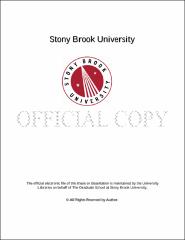| dcterms.abstract | Cancer is a fundamentally heterogeneous at virtually every level, ranging from the anatomic site of origin to the histologic type, degree of differentiation, and the underlying pathogenetic mechanisms. Despite dramatic progress in our ability to define cellular and molecular heterogeneity, there has been limited progress in the identification of the cellular mechanisms that define the tumor biology, treatment response, and patient outcome. Prognostic markers have the potential to not only identify patients at greatest risk for disease progression and death, but may also be the underlying drivers that mediate tumor aggression. In turn, these markers could also represent therapeutic targets. One overarching objective of the work presented in this thesis was to identify a novel cancer biomarker(s) that is prognostic for tumor progression and patient survival, independent of clinic-pathologic parameters that traditionally are used to classify cancer status in clinical specimens. This aim was fulfilled by the identification of keratin 17 (K17) as an independent predictor of patient survival, overexpressed in biologically aggressive cervical and pancreatic cancers. The second primary goal of this thesis was to evaluate the molecular basis for how K17 fundamentally impacts cancer-cell biology and furthermore, to gain insight into how this oncoprotein could one day be exploited as a novel therapeutic target to achieve improved long term survival. In this study, we took an unbiased approach to identify, validate, and characterize the fundamental function of a cancer prognostic biomarker. First, we describe how we identified and validated K17 as a prognostic biomarker, independent of multiple clinicopathologic features, by proteomic and immunohistochemical methods, using multiple retrospective case series of squamous-cell cervical cancers (Chapter II). In addition, we determined that the prognostic value of K17 extended beyond its utility in cervical cancer into other carcinomas. In Chapter III, we describe the results found on pancreatic ductal adenocarcinomas, where we identified that either protein or mRNA levels of K17 provide complementary survival information to the current standard-of-care prognosis model for this malignancy. Keratins are a diverse group of evolutionarily conserved proteins and are expressed in a tissue dependent, cell type-dependent, and context-dependent fashion in the body. These proteins are important protectors of epithelial structural integrity and have also been recognized as regulators of other normal cellular functions, including signaling, growth and protein synthesis (Chapter IV). In cancer, keratins have traditionally been used as diagnostic tools, but accumulating evidence, from our studies and other independent studies, points to their importance as active regulators of epithelial tumorigenesis. In Chapter V, we describe the discovery of the mechanistic basis for the biological impact of K17 in human cervix, breast and pancreatic cancer cells. Through loss and gain of function experiments, we specifically determined that K17 functions as an oncoprotein by regulating the subcellular localization and degradation of tumor suppressor p27KIP1. We found that K17 was released from intermediate filaments and translocated into the nucleus via a nuclear localization signal (NLS), unique among keratins, where it bound p27KIP1 during G1 phase of the cell cycle. p27KIP1 lacks a nuclear export signal (NES) and requires an adaptor for CRM1 binding for nuclear export. Cervical cancer cells expressing K17 mutations in its NLS or NES signals exhibited an increase in levels of nuclear p27KIP1, whereas cells expressing wild-type K17 exhibited a depletion in total endogenous p27KIP1. Overall, these findings establish that K17 functions as an oncoprotein, by controlling the ability of p27KIP1 to influence cancer pathogenesis (Chapter V). In Chapter VI, we discuss the current understanding of the multiple roles of K17 in cancer and address potential future directions for our research that are based on these unresolved challenges. The finding of the association between K17 expression in cancer cells and poor outcome of cancer patients highlights the prognostic value of keratins in cancer, beyond their use as cancer diagnostic markers. Furthermore, this project identified the molecular mechanisms through which K17 promotes aberrant cell cycle progression. Together, this work has demonstrated that K17 could be a tool to improve the predictive value of the histologic assessment of tumors and provided new insight into the mechanisms that mediate the biologic aggression of cancer. Future studies may lead to the discovery of other oncogenic pathways through which nuclear K17 drives tumor aggression, to ultimately define K17 as a potential novel therapeutic target for cancer. | |

